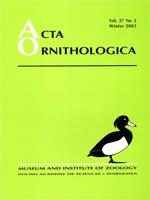Foraging observations (1 observation/bird) of tits and associated species were recorded during four winter months in two natural old-growth and two managed forests. The number of daily foraging observations was used as an index of bird abundance. The daily mean number of foraging observations for Parus major, P. caeruleus, P. palustris, Sitta europea, Certhia familiaris and Dendrocopos major was significantly higher in natural old-growth vs managed forest (ratio 4.8 : 1 for all six species pooled and 3.1 : 1, 3.2 : 1, 4.7 : 1, 5.7 : 1, 7.4 : 1 and 4.7 : 1 for the above-mentioned species, respectively). As the larger dominant species has an advantage in competition for nest holes, we would expect these to exhibit the smallest abundance ratio skews. This was not, however, the case and consequently, the results of this study do not support the hypothesis that a lack of nest holes should be the primary limiting factor for hole nesting species in managed forests. It was found that the species showing the strongest preference for foraging on dead wood were the same that had the most pronounced density skew between forest types. This could indicate that the lack of food resulting from silvicultural practice could be very important as a limiting factor in managed forests. Analyses of the use of dead wood of different diameter and from different tree species indicate that forest birds exploit diverse types of dead wood. Partially decayed standing dead wood was the most important substrate for the majority of species.
How to translate text using browser tools
1 December 2002
Winter Abundance of Hole-Nesting Birds in Natural- Versus Managed Woods in Zealand (Denmark)
Jens Bursell

Acta Ornithologica
Vol. 37 • No. 2
December 2002
Vol. 37 • No. 2
December 2002
abundance of birds
dead wood
foraging of birds
forest microhabitats
hole-nesting birds
natural forest




